

This article is an excerpt from the Shortform book guide to "How to Do the Work" by Nicole LePera. Shortform has the world's best summaries and analyses of books you should be reading.
Like this article? Sign up for a free trial here.
What are behavior patterns in psychology? Which patterns are potentially harmful? What is self-sabotage?
Holistic psychologist and bestselling author Nicole LePera says certain experiences from your childhood could be affecting you as an adult, creating psychological behavior patterns that harm your wellbeing. Her book, How to Do the Work, teaches you which pattern you need to change.
Read on to learn how to identify and address the behavior pattern that LePera says could be most harmful.
Behavior Patterns & Why You Self-Sabotage
In Nicole LePera’s book, How to Do the Work, she addresses behavior patterns in psychology, arguing that you can live a healthier, happier life by taking control of your unwanted patterns—such patterns stem from unresolved childhood traumatic experiences, according to LePera. Therefore, the key to overcoming unwanted patterns lies in addressing these traumas:
- Understand the root cause of your psychological behavior patterns
- Become more conscious of how childhood conditioning impacts your mental and physical health
- Develop positive behavior patterns that improve your well-being
- Feel happier, healthier, and more in control of your life
Identifying Your Patterns
In her book, LePera argues that your reliance on defensive beliefs and behavior patterns helps you to psychologically avoid feeling pain. However, this doesn’t end in childhood but, rather, follows you into adulthood. She clarifies why your childhood conditioning continues to influence you by exploring three aspects of your subconscious mind:
- Your subconscious mind relies on psychological behavior patterns by default.
- Your subconscious mind’s primary role is to keep you safe.
- Your subconscious mind protects you by creating discomfort.
Psychologically, your subconscious mind believes that your default behavior patterns keep you safe, so it resists any attempts to change them. This resistance takes the form of mental and physical discomfort that you experience each time you attempt to deviate from your default behavior patterns.
For example, you might experience anxious or negative thoughts, uncomfortable cravings, tension headaches, or stomach cramps. LePera claims that your subconscious mind creates this discomfort to convince you to revert to your default behavior patterns—even those that cause you psychological pain or physical harm.
For example, your classmates hurt your feelings by excluding you from group activities. You adopted the defensive belief that avoiding social interactions prevents the pain of rejection. As a result, your subconscious mind psychologically associated social interactions with pain and rejection and created a default behavior pattern that influences you to automatically withdraw into yourself when you’re around others. Any time you attempt to break free of this pattern and engage with others, you become overly self-conscious, sweat profusely, and feel nauseous. To relieve this psychological or even physical discomfort, you withdraw into yourself and avoid engaging in unnecessary interactions—thus preserving your default behavior pattern.

———End of Preview———
Like what you just read? Read the rest of the world's best book summary and analysis of Nicole LePera's "How to Do the Work" at Shortform.
Here's what you'll find in our full How to Do the Work summary:
- How childhood conditioning impacts your mental and physical health
- How to develop positive patterns that improve your well-being
- Tools to feel happier, healthier, and more in control of your life






